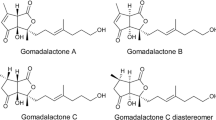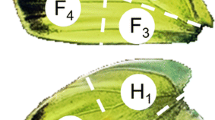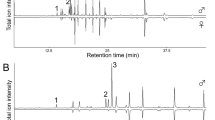Abstract
Sex pheromone extracted from glands on the forewings of maleEphestia elutella (Hübner) elicits a stereotyped courtship response from conspecific females. A bioassay for this sex pheromone was developed based on this behavior. Maximum production and responsiveness for males and females, respectively, occurred in insects more than 24 hr old.E. elutella females were not responsive to extracts made fromE.figulilella Gregson,E. kuehniella Zeller,E. cautella (Walker), orPlodia interpunctella (Hübner) males.
Similar content being viewed by others
References
Baker, T.C., andCardé, R.T. 1979. Courtship behavior of the Oriental fruit moth (Grapholitha molesta): Experimental analysis and consideration of the role of sexual selection in the evolution of courtship pheromones in the Lepidoptera.Ann. Entomol. Soc. Am. 72:173–188.
Barrer, P.M., andHill, R.J. 1977. Some aspects of the courtship behaviour ofEphestia cautella (Walker) (Lepidoptera: Phycitidae).J. Aust. Entomot. Soc., 16:301–312.
Barrer, P.M., andHill, R.J. 1978. The acceptance response ofEphestia cautella (Walker) (Lepidoptera: Phycitidae) females obtained in the absence of courting males.Experientia 34:343–344.
Barth, R. 1937. Bau und Funktion der Flügeldrüsen einiger Mikrolepidopteren. Untersuchungen an der Pyraliden:Aphomia gularis, Galleria mellonella, Plodia interpunctella, Ephestia elutella andE. kühniella.Z. Wiss. Zool. 150:1–37.
Birch, M.C. 1970. Pre-courtship use of abdominal brushes bythe nocturnal moth,Phlogophora meticulosa (L.) (Lepidoptera: Noctuidae).Anim. Behav. 18:310–316.
Birch, M.C. 1974. Aphrodisiac pheromones in insects, pp. 115–134,in M.C. Birch (ed.). Pheromones. North Holland Publishing Company, Amsterdam.
Boppre, M.R., Petty, L., Schneider, D., andMeinwald, J. 1978. Behaviorally mediated contacts between scent organs: Another prerequisite for pheromone production inDanaus chrysippus males (Lepidoptera).J. Comp. Physiol. 126:97–103.
Brower, L.P., Brower, J.V.Z., andCranston, F.P. 1965. Courtship behavior of the queen butterfly,Danaus gillippus (Cramer).Zoologica 50:1–39.
Calvert, I., andCorbet, S.A. 1973. Reproductive maturation and pheromone release in the flour moth,Anagasta kuehniella (Zeller).J. Entomol (A) 47:201–209.
Clearwater, J.R. 1972. Chemistry and function of a pheromone produced by the male of the southern army worm,Pseudaletia separata.J. Insect Physiol. 18:781–789.
Conner, W.E., Eisner, T., Vander Meer, R.K., Guerrero, A., andMeinwald, J. 1981. Precopulatory sexual interaction in an arctiid moth (Utetheisa ornatrix): Role of a pheromone derived from dietary alkaloids.Behav. Ecol. Sociobiol. 9:227–235.
Dickens, G.R. 1936. The scent glands of certain Phycitidae (Lepidoptera).Trans. R. Entomol Soc. London 85:331–362.
Ganyard, M.S., Jr. 1971. Studies on the attractive properties of the sex pheromone of the Indian meal moth,Plodia interpunctella and related species in indoor and outdoor environments. Doctor of Philosophy dissertation, University of Georgia, Athens.
Grant, G.G. 1976a. Courtship behavior of a phycitid moth,Vitula edmandsae.Ann. Entomol. Soc. Am. 69:445–449.
Grant, G.G. 1976b. Female coyness and receptivity during courtship inPlodia interpunctella (Lepidoptera: Pyralidae).Can. Entomol. 108:975–980.
Grant, G.G., andBrady, U.E. 1975. Courtship behavior of phycitid moths. I. Comparison ofPlodia inlerpunctella andCadra cautella and role of male scent glands.Can. J. Zool. 53:813–826.
Hoppe, T., andLevinson, H.Z. 1979. Befallserkennung und Populationsüerwachung vorratsschadlicher Motten (Phycitinae) in einer Schokoladenfabrik mit Hilfe pheromonbeköderter Klebefallen.Anz. Schaedlingskd. Pflanz. Umweltschutz 52:177.
Krasnoff, S.B., Vick, K.W., andMankin, R.W. 1983. Female calling behavior inEphestia elutella andE. figulilella (Lepidoptera: Pyralidae).Fla. Entomol. 66:249–254.
McLaughlin, J.R. 1982. Behavioral effect of a sex pheromone extracted from forewings of malePlodia interpunctella.Environ. Entomol. 11(2):378–380.
Nishida, R., Baker, T.C., andRoelofs, W.L. 1982. Hairpencil pheromone components of male Oriental fruit moths,Grapholitha molesta.J. Chem. Ecol. 8:947–959.
Palaniswamy, P., Seabrook, W.D.,andRoss, J.R. 1979. Precopulatory behavior of males and perception of a potential male pheromone in spruce budworm,Choristoneura fumiferana.Ann. Entomol. Soc. Am. 72:544–551.
Richards, O.W. 1927. Sexual selection and allied problems in the insects.Biol. Rev. 2:298–360.
Roesler, R.V. 1973. Die trifinen Acrobasiina der Phycitinae. (Lepidoptera, Pyralidae) inMicrolepidoptera palaearctica. G. Fromme, Vienna.
Rutowski, R.L. 1977. Chemical communication in the courtship of the small sulphur butterfly.Eurema lisa (Lepidoptera: Pieridae).J. Comp. Physiol. 115:75–85.
Silhacek, D.L., andMiller, G.L. 1972. Growth and development of the Indian meal moth,Plodia interpunctella (Lepidoptera: Phycitidae).Ann. Entomol. Soc. Am. 65:466–468.
Willis, M.A., andBirch, M.D. 1982. Male lek formation and female calling in a population of the arctiid moth,Estigmene acrea.Science 218:168–170.
Zagatti, P. 1981. Comportement sexuel de la Pyrale de la Canne à sucreEldana saccharina (Wlk.) Lié à deux phéromones émise par le male.Behavior 78(parts 1–2):79–98.
Author information
Authors and Affiliations
Additional information
Mention of a commercial or proprietary product does not constitute an endorsement by the USDA.
Rights and permissions
About this article
Cite this article
Krasnoff, S.B., Vick, K.W. Male wing-gland pheromone ofEphestia elutella . J Chem Ecol 10, 667–679 (1984). https://doi.org/10.1007/BF00994227
Received:
Revised:
Issue Date:
DOI: https://doi.org/10.1007/BF00994227




